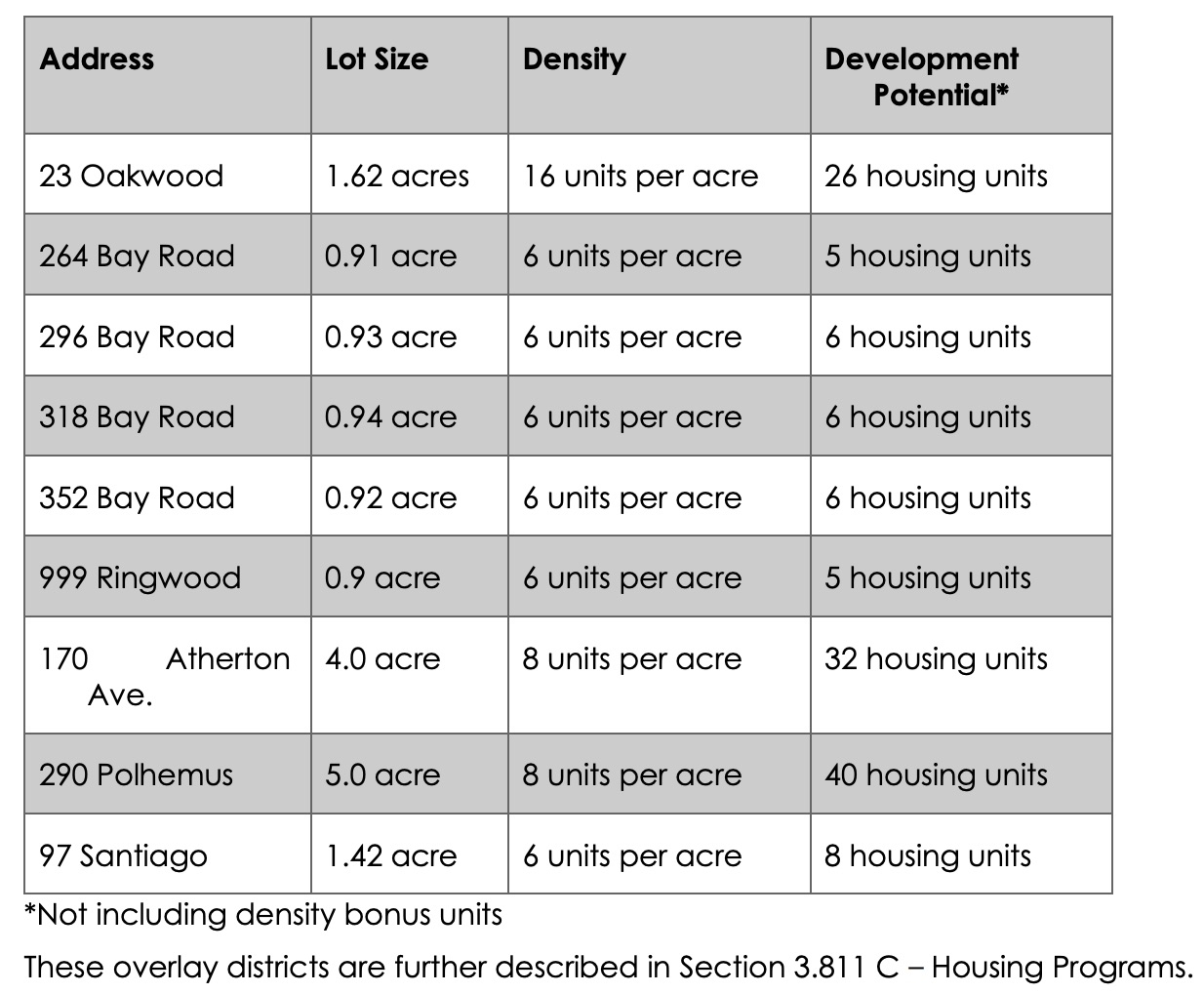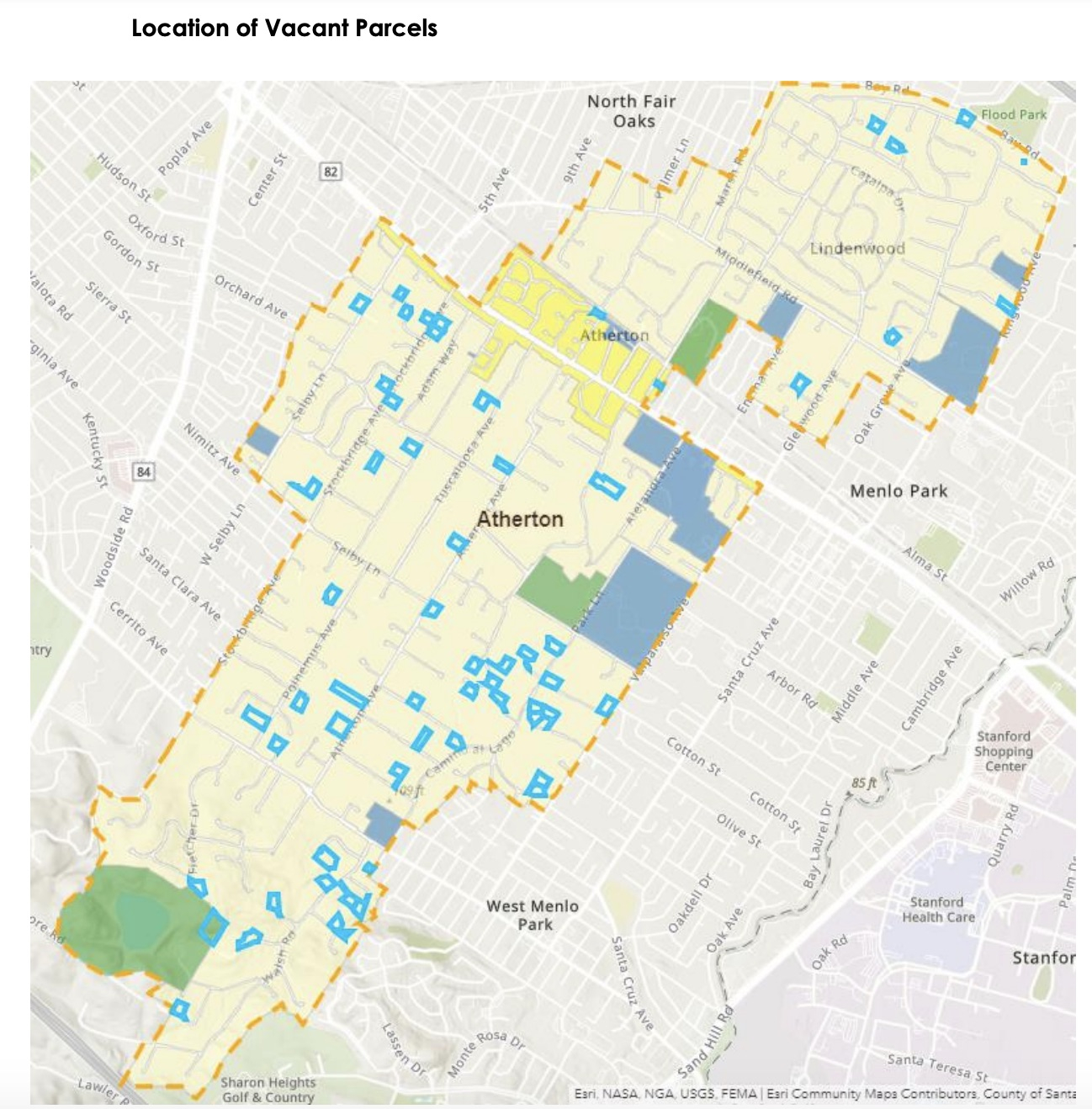Atherton may see townhouses for the first time in its history, with pressure mounting to zone for more homes under the state-mandated housing element update.
Although there is faculty and student housing at some schools in town, multifamily housing has never been seen outside of those narrow uses.
The City Council reviewed its draft 2023-31 housing element at a Wednesday, June 15, meeting. Town staff released the draft for public comment on June 10.
The town must plan for the development of 348 new housing units, a large jump from its designation of 93 units during the previous eight-year cycle. The proposal also includes a buffer, bringing the total units planned to 462.
Towns and cities also face significant exposure to liability, according to the state. Courts may revoke the local government's land use and planning authority, and local government agencies deemed out of compliance may be subject to judgments and fines of up to $100,000 per month.
But recognizing the "extreme housing shortage" in California and the Peninsula, the town wants to do its part in meeting the assigned RHNA production, while maintaining the existing town character and preserving heritage trees, according to the draft element.
Councilman Bob Polito said that some residents think the housing element is a "vindictive plan" by the council and city manager, and that it's not.
Unless there is a referendum that takes control of local jurisdictions away from the state, towns have to comply, he said. Some residents have demanded the town refuse to create a housing element.
At the June 15 meeting, some residents asked that the town's general land use plan be updated (it was last revised two years ago) before proceeding with a housing element. They also brought up concerns about new multifamily housing bringing traffic and crime to Atherton.
"We have a problem if we submit a plan to HCD that's not a good faith plan," Polito said. "These guys aren't going to put up with any baloney."
New housing overlays
At a May 24 meeting, council members were divided on where to put multifamily zoning overlays. They settled on the following sites:
One of the recommended changes that staff will recommend on July 20 will be to remove 290 Polhemus Ave. as a potential overlay zone candidate because the property owner isn't interested in developing it, DeGolia told The Almanac.
DeGolia, who said he's received about 100 emails recently on the housing element, noted at last week's meeting that he is personally against developing the property because a hill on Alameda de Las Pulgas makes it impossible for people to see traffic coming when they turn off Polhemus. He said he didn't know this until he visited the site.
"We made mistakes on May 24," he said. "We added three properties and increased density. I would have liked to have vetted these things more."
DeGolia said he also knows that homeowners do not support development at the Polhemus and Santiago locations.
Schools
Menlo College, at 1000 El Camino Real, currently has 21 housing units for faculty and staff and is "very interested" in providing additional housing on campus, according to staff.
If the school buys adjacent parcels, the town would strongly consider including those parcels within the newly created multifamily overlay zones. This would enable the schools to develop housing for teachers and staff, as well as for a revenue stream for the schools should the units be rented to the public.
Menlo College broke ground on a $20 million 288-bed residence hall in spring 2021. The school is in the final stages of construction on the project now, said Angela Schmiede, vice president for student success & strategic planning chair for the college. Menlo College plans to host a ribbon cutting in August for the new dorms, she said.
The dorms won't count toward the town's RHNA targets because they are not considered permanent housing, Town Planner Lisa Costa Sanders said last year.
Menlo School, at 50 Valparaiso Ave., has expressed interest in acquiring land adjacent to the school and developing 10 to 20 units within this housing element cycle.
Sacred Heart Schools, located at 150 Valparaiso Ave., currently has five apartments on campus for retired nuns. The school expects to renovate the building in the next 15 to 20 years to accommodate faculty housing, which falls outside of the current RHNA cycle.
CalWater Bear Gulch Reservoir
CalWater owns and operates 99 acres at the Bear Gulch Reservoir, 120 Reservoir Rd., and is interested in constructing four new affordable housing units at this site to help retain and recruit new employees, according to the draft housing element.
This existing zoning for the property allows for caretaker housing with a conditional use permit. The town plans to amend the zoning to allow low- and moderate-income multifamily housing by right.
Underutilized parcels
Town staff created a list of 65 residential parcels that are "underutilized" since they are of sufficient size to be further subdivided, according to the draft element.
For example, under the state's new duplex law Senate Bill 9, 59 parcels could be split into two legal parcels, and each parcel could have to units each. This could lead to up to 118 units.
The town has received four applications for SB 9 lot splits — at 78 Cebalo Lane, 2 Lowery Drive, 125 Glenwood Ave. and 94 Palmer Lane — so far. There are three pending applications, at 47 Santiago Ave., 190 Selby Lane and 197 Glenwood Ave. Atherton expects to see about nine to 32 net new dwelling units per year with SB 9, according to staff.
'Unprecedented' level of pressure from state
Southern California towns and cities are ahead of Northern California in the housing element cycle. As of June 15, only eight of the 124 jurisdictions in Los Angeles and Orange counties have been found in compliance, according to Town Manager George Rodericks in a blog post. The remainder are still in the process of review and approval with the state's department of Housing and Community Development, according to Rodericks.
"This level of pressure and exhausting engagement by the state in the sixth cycle process is, to use an unfortunate word, unprecedented," he wrote.
Roadblocks for building
Land scarcity and high real estate prices are the most significant constraints to affordable housing in Atherton, according to the draft housing element, which must identify and address the hurdles impacting housing growth. There are virtually no vacant lots in Atherton.
Land currently sells for about $8 million per acre and can only be acquired by purchase of a developed parcel or by subdividing the property, which also likely involves the removal of an existing home, according to the town.
The inventory of sites suitable for residential development shows a potential of approximately 110 new parcels that can be created by subdividing existing developed parcels.
Next steps
The public has until July 11 to comment on the draft element. The Planning Commission will review the plan at a June 23 meeting at 1 p.m.
At the close of the comment period, the City Council will review the draft element and any submitted comments at its July 20 meeting. The draft will then be sent to HCD for review.
More information on the housing element can be found online.







Comments